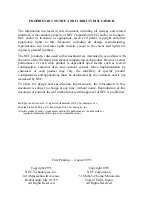
19
For optimum service, adjust the power supply to the float voltages shown
in Table 3. If the power supply is intermittent or more frequent discharges
are anticipated, use a higher value recommended voltage setting.
Note: For locations that exhibit frequent temperature variations it is
recommended that temperature compensated rectifiers be
used that adjust the voltage in accordance with sub-sections
3.4 and 3.5 of Section 3.
2.2 Equalizing charge
Under normal operating conditions, it should not be necessary to
equalize batteries when charged at the recommended voltage in
Tables 2 and 3. An equalizing charge delivered at a voltage higher
than the nominal float voltage is used to restore uniform cell voltage to
a battery.
Note 1: Some hydrogen gas may be liberated at equalize charging
voltage.
An equalizing charge can be provided when individual cell voltages go
below the minimum value shown in Table 3 or 0.05 Volts below the
minimum float voltage specified in Table 3. Remember to divide the
number of cells into unit voltage to arrive at cell voltage. Presence of a
minimum voltage does not imply a battery is malfunctioning or that it
will not provide the necessary power when called upon.
Note 2: Chargers must be current limited to 25 Amperes per 100-
Ampere-hour battery rating. Higher charging currents could
potentially destroy the battery by overheating. This heating
can subsequently cause more current to flow, creating a
vicious cycle sometimes referred to as “thermal runaway.”
Note 3: Minimum voltage is the point at which plans should be made
to provide an equalizing charge. Note that the normal equal-
ize voltage level (initial charge level) will not be effective in
VRLA product as the voltage is not high enough to enable the
negative plates to charge. An equalizing charge of 2.45 volts
per cell can be applied to the string or problem cell/unit for a
period not exceeding eight hours. Consult the C&D
Technologies Technical Service Department for answers to
specific questions.
2.3 Over-voltage
When a charger is improperly set or a panel meter is improperly
calibrated battery over-voltage or under-voltage may result. Higher
than normal battery voltage can damage a battery, significantly
shortening its service life. This is especially important in valve-
regulated product where over-voltage increases gas generation that
could cause pressure build-up within the cell. The excess pressure will
cause the cells to vent the gases generated, causing premature dry out
of the battery electrolyte. Even a small increase in over-voltage,
beyond what is recommended in Table 3, increases the corrosion rate
of the positive grid element and will contribute to reduced battery life.
Содержание LIBERTY 1000 Series
Страница 1: ...LIBERTY SERIES 1000 Valve regulated Lead Acid Batteries Installation and Operating Instructions RS 990...
Страница 31: ...29 14 312...
Страница 32: ...30...
Страница 33: ...31 14 312...
Страница 34: ...32 14 332...
Страница 35: ...33...
Страница 36: ...34...
Страница 41: ...39 NOTES...
Страница 42: ...40 NOTES...
















































